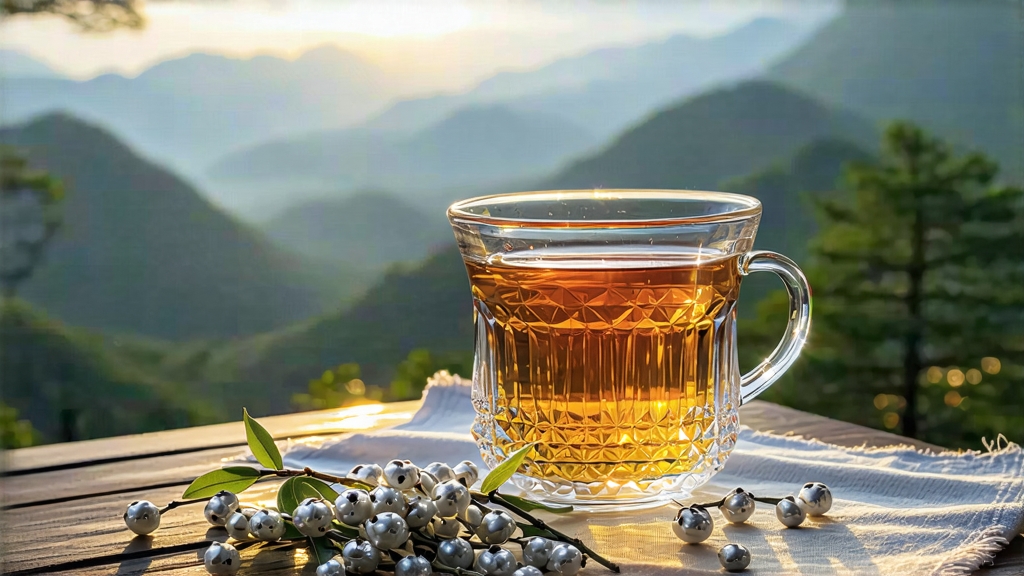
If green tea is the bright youth of Chinese tea and pu-erh its venerable elder, then Fuding White Needle—Bai Hao Yin Zhen in Mandarin—occupies the contemplative hour just before moonrise. Grown on the hilly, red-soil coast of northern Fujian, this least-handled of all teas is prized for what the leaf is allowed to keep: spring dew, sea breeze, and the slow passage of time. To understand it is to listen rather than to speak; its story is told in the hush of withering barns and the soft rustle of silver buds falling onto bamboo trays.
History: From Imperial Tribute to Global Muse
References to “white tea” appear in Song-dynasty treatises, yet the term then described the pale color of any young infusion. The cultivar-specific White Needle emerged during the late Ming, when coastal growers of Fuding began selecting the large-bud Da Bai Hao strain, whose fat, down-covered tips resembled sewing needles. By the Qing’s Qianlong era, these buds were pressed into cakes, shipped north along the Tea-Horse Road, and presented at court as a cooling remedy for “imperial fire.” When British plant-hunter Robert Fortune passed through Fuding in 1851, he noted “peculiar white-haired leaves of delicate flavor,” unknowingly seeding future European curiosity. The 1915 Panama-Pacific Expo awarded a Fuding Yin Zhen gold medal, and in the 21st century the tea has become the darling of specialty cafés from Melbourne to Montreal, valued for both its ethereal taste and low intervention craft.
Terroir & Harvest: Where Granite Meets the East China Sea
Fuding County sits at 27° N latitude, a sweet spot where subtropical humidity collides with granitic, well-drained soils. Two cultivars dominate: Fuding Da Bai Hao (“Big White Down”) and the even plumper Da Hao. Only the unopened bud, picked for a fleeting ten-day window before Qingming (early April), qualifies for true Yin Zhen. Pickers work at dawn while dew still beads the leaf; any later and enzymatic activity accelerates, risking a dull liquor. A single kilo of finished tea demands roughly thirty thousand buds, all carried in wicker baskets lined with banana leaves to prevent bruising.
Craft: The Art of Doing Almost Nothing
White Needle’s processing is disarmingly simple yet maddeningly precise. After picking, the buds are spread one layer deep on water-reed trays and left to wither for 36–48 hours in naturally ventilated barns. Night mountain air cools the leaf, while daytime sea breezes bring warmth; the fluctuation drives off moisture without “killing-green” as in pan-fired teas. No rolling, no shaking, no roasting—only a final 20-minute bake at 40 °C to reach 8–9 % residual moisture. The result is a tea that retains the original shape of the bud, now capped with a silvery fuzz that sparkles under light like frost on a plum branch.
Chemistry in Slow Motion
Minimal heat means active enzymes survive. During months of post-fermentation (not microbial like pu-erh, but oxidative), catechins convert into theaflavins and fragrant lactones, while chlorophyll degrades into pheophytin, lending the dried leaf its characteristic grey-green hue. The ratio of amino acids to polyphenols hovers around 0.4, higher than most green teas, yielding the signature brothy sweetness that Japanese tea scientists call “umami in white.”
Grades & Market Names
Although China’s national standard lists only three white tea grades—Yin Zhen, Bai Mu Dan, and Shou Mei—connoisseurs subdivide Yin Zhen further:
- “Tribute Needle”: buds longer than 2.5 cm, picked before the Qingming festival, charcoal-baked at below 35 °C.
- “Forest Needle”: wild-grown buds from 100-year-old bushes on Taimu Mountain, carrying camphor and orchid notes.
- “Moonlight Needle”: withered entirely at night under mesh screens, said to emphasize cooler, muscatel aromatics.
Brewing: Finding the Quiet Center
Western cup method: 3 g per 250 ml, 80 °C water, 4 minutes. The liquor glows like pale chardonnay, releasing hints of honeydew